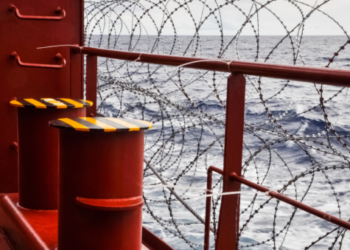ITOPF has published a report highlighting the distinct nature of claims arising from hydrogen spills compared to traditional oil spills, focusing on the unique impacts associated with hydrogen’s toxicity and reactivity.
As explained in the “Fate, Behaviour and Potential Damage & Liabilities Arising From a Spill of Hydrogen Into the Marine Environment” report, hydrogen has been viewed as a viable option for shipping’s decarbonisation journey as it is one of the few alternative fuels that can be classed as ‘emission-free’ (only if the hydrogen is produced by the electrolysis of water using renewable energy, i.e. ‘green hydrogen’).
The use of hydrogen as a fuel for shipping can be in multiple states, such as liquefied or compressed hydrogen within internal combustion engines, or using LH2 within fuel cells. Due to the economic and technical barriers facing hydrogen technology and infrastructure development, the industry is immature when compared to other marine alternative fuels, and therefore these technologies may develop in the future, with one format potentially being more technically viable than others.
The Standard European Behaviour Classification (SEBC) categorises hydrogen as a gas (G). During an incident, hydrogen’s hazards will be the drivers for the first actions and emergency response, followed by specific actions linked to its behaviour classification.
| Property | Behaviour |
|---|---|
| Boiling Point | -253 °C. At ambient conditions, hydrogen is a gas. |
| Liquid Specific Gravity (@-253 °C) | 0.071. Hydrogen is approximately 14 times less dense than water; therefore, as a liquid, LH2 will float if spilled on water. |
| Gas Specific Gravity (@-253 °C) | 1.338. Saturated vapour is heavier than air and will remain close to the ground until the temperature rises. |
| Vapour Specific Gravity (@ambient Temp) | 0.067. Vapours of hydrogen at ambient conditions are significantly lighter than air (buoyant) and will easily disperse in open or well-ventilated areas. |
| Solubility | Insoluble. Hydrogen will not mix with water (run-offs) or seawater. |
| Flammability Range | 4.0 – 75.0 (v/v) %. Outside of this range, hydrogen/air vapour mixture is not flammable. |
Hazards of hydrogen when spilled in the marine environment
Hydrogen’s hazards can lead to direct impacts on health and safety, mainly through its flammability and explosivity.
Flammability
LH2 is not flammable, however, its vapour has a flammability range of 4 – 75 (v/v) %, which can be detected with specialised equipment. Outside of this range, the hydrogen/air mixture is not flammable. This is greater than conventional fuels such as diesel, which has a much smaller flammability range of 0.6 – 5.5 (v/v) %. In an unconfined space, a release of LH2 from a tank or pipeline will rapidly mix and dissipate into the atmosphere, reaching concentrations below the 4% LFL. Only a small area near the immediate leak would likely reach the concentration that would allow hydrogen to ignite.
In a confined space, where flammable vapours cannot dissipate, a small leak would result in a stratified layer of hydrogen at high points in that space (e.g. at ceiling height), which could lead to a flammable vapour/air mixture. Note that inside a fuel storage tank, the percentage of hydrogen is almost pure and, as such, the conditions are not in its flammable range. However, following a leak/rupture, a vapour cloud will form and once it has mixed with air, when its concentration reaches between the LFL (4% volume) and the upper flammability limit (UFL) (75% volume), the mixture can sustain a flame if ignited. If ignition occurs immediately, a flash fire is likely to result and continue until all the fuel is consumed. It should be noted that hydrogen-air flames are colourless and therefore have low visibility, especially in daylight conditions. Hydrogen fires also have low radiant heat and therefore, it is difficult to sense the location of the fire until in close proximity.
Explosivity
Hydrogen has a wide range of explosivity limits (15 – 59 (v/v) %), and as a result, even small leaks have the potential to burn or explode. If leaked, hydrogen concentrates in a confined space, there is a significant risk of combustion and explosion, meaning that even an invisible spark or static electricity discharge may cause ignition. Ignition of a flammable vapour/air mixture may result in a possible deflagration to detonation transition (DDT) and a subsequent large explosion due to high burning velocities of hydrogen-air flames and shorter burning distances needed to initiate a DDT event. These have been reported in the past but are unpredictable and not well understood at this time.
Compressed hydrogen
Hydrogen released in sufficient quantities can create a harmful overpressure, which may result in direct and indirect hazards from building damage or flying debris. Overpressures can occur as a result of unignited releases of pressurised gas or as a result of ignition of a cloud of released flammable gas.
Liquid hydrogen
In particular conditions, LH2 could potentially undergo a boiling liquid expanding vapour explosion (BLEVE), which is an explosion caused by the rupture of a tank containing a pressurised liquid that has reached a temperature above its boiling point of -253 °C. This would be the case if the temperature of the tank were to raise and gas release systems were to fail.
When exposed to ambient conditions, spilled LH2 may result in a rapid phase transition (RPT), which is a flameless overpressure due to a very fast change of phase, from liquid to gas. The vapour cloud expands so quickly that a sonic boom and localised overpressure occurs. It should be noted that no LH2 RPT incidents have been reported, with some studies indicating the likelihood of an RPT event caused by LH2 is considerably smaller than LNG. Similar to DDT events, RPT events involving LH2 are not well understood at this time.
Asphyxiant
Like any gas in a confined environment, high concentrations of hydrogen vapours displace oxygen in the air, decreasing oxygen availability and leading to asphyxiation in confined environments.
Temperature
The cryogenic temperature of LH2 will result in the freezing of any tissue (plant or animal) upon contact and can cause materials to become brittle and lose their strength or functionality.































































